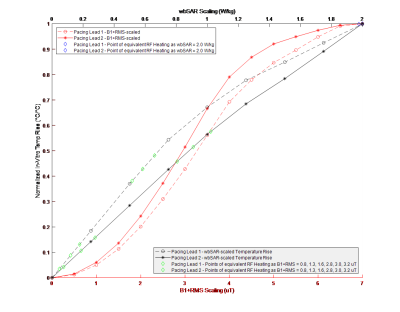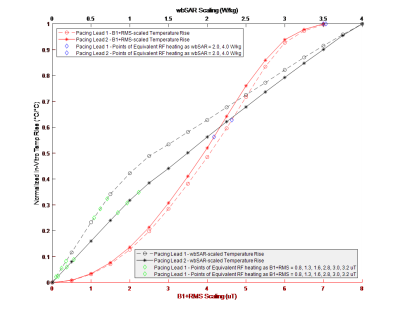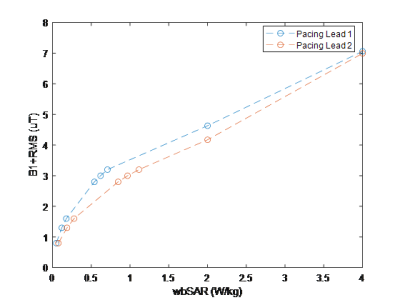4820
Comparing 1.5T MRI RF Heating Based on SAR vs. B1+RMS MR Conditional Labeling1Research and Development, Abbott, Sunnyvale, CA, United States, 2Abbott, sylmar, CA, United States
Synopsis
With the emergence of B1+RMS as a more precise RF exposure metric than SAR, implantable device manufacturers have begun MR Conditional labeling to fixed B1+RMS levels, in addition to SAR labeling. We previously characterized the relationship between wbSAR-scaled and B1+RMS-scaled RF heating of cardiac pacing leads in the context of 3T Normal Operating Mode and First Level Controlled Mode MRI exposure [1]. In this study, we extend the analysis to 1.5T.
Introduction
MRI RF heating can cause thermal damage to biological tissues. Assessment of MRI RF-induced heating for active implantable medical devices (AIMDs) requires electromagnetic simulations of clinical RF coils to generate probable RF E-fields that can induce currents along the length of implants, leading to concentrated power deposition at the implant-tissue interface. The simulated coil excitations must be consistent with the MR Conditional labeling, ranging across Normal Operating Mode, First-Level Controlled Operating Mode, fixed whole-body Specific Absorption Rate (wbSAR) or fixed B1+RMS levels. B1+RMS has been adopted by AIMD manufacturers as an additional RF exposure metric for MR Conditional labeling, given that it is neither estimated nor patient-dependent like SAR. When both SAR and B1+RMS levels are specified in MR Conditional labeling, questions remain around which is less restrictive. Our investigation aims to characterize equivalence between wbSAR-scaled and B1+RMS-scaled RF heating predictions in the context of 1.5T Normal Operating Mode and First Level Controlled Mode MRI exposure with a cardiovascular implantable electronic device (CIED), extending our prior analysis for at 3T [1].Methods
We evaluated two different cardiac pacing leads connected to a CIED, for 1.5T MRI In Vivo RF heating (Circular Polarization excitation only) limited by Normal Operating Mode or First Level Controlled Mode limits. In-vitro temperature rise values were derived for RF exposures scaled to a range of wbSAR values across 0-4.0 W/kg with a maximum B1+RMS scaling of 7 uT, as well as for fixed B1+RMS values across 0.5-7.0 uT with a maximum wbSAR scaling of 2.0 W/kg vs. 4.0 W/kg for Normal and First Level Operating Mode respectively. We identified wbSAR values at which heating predictions were equivalent to specific B1+RMS levels, namely 0.8, 1.3, 1.6, 2.8, 3.0, and 3.2 uT, values which AIMD manufacturers currently use in their MR Conditional labeling [2-4], as well as B1+RMS values at which heating predictions were equivalent to specific wbSAR levels of 2.0 and 4.0W/kg, maximum limits imposed by Normal and First Level Controlled Operating Mode respectively.Results
The normalized in-vitro temperature rise was quantified for multiple 1.5T Normal Operating Mode wbSAR-scaled (black) and B1+RMS-scaled (red) RF heating simulations for two different cardiac leads (Figure 1). The same is presented for the constraint of First-Level Controlled Mode in (Figure 2).The (wbSAR, B1+RMS) levels at which the temperature rises are equivalent under Normal Operating Mode, are plotted in Figure 3, similar across the two leads: (0.1, 0.8), (0.1, 1.3), (0.2, 1.6), (0.5, 2.8), (0.6, 3.0), (0.7, 3.2), (2.0, 6.9).
The (wbSAR, B1+RMS) levels at which the temperature rises are equivalent under First Level Controlled Operating Mode, are plotted in Figure 4, similar across the two leads: (0.1, 0.8), (0.2, 1.3), (0.2, 1.6), (0.5, 2.8), (0.6, 3.0), (0.7, 3.2), (2.0, 4.1), (4.0, 7.0).
Discussion
Our study shows that in terms of induced RF heating, on-market 1.5T B1+RMS labeling such as 3.0uT [3], is equivalent to a wbSAR as low as 0.6W/kg under Normal Operating Mode or First-Level Controlled Mode limits. Additionally, a wbSAR limit of 2W/kg is equivalent to B1+RMS as low as 6.9uT under Normal Operating Mode and 4W/kg is equivalent to 7.0uT under First Level Controlled Mode.Per the identical investigation previously carried out for 3T [1], the same wbSAR level (e.g. 2W/kg) is found to be equivalent in RF heating to a notably larger B1+RMS at 1.5T (6.9uT) than at 3T (4.5uT) under Normal Operating Mode limits. This observation is consistent with previously published clinical datasets [5], where it was shown the same B1+RMS labeling is much more limiting at 1.5T than at 3T. As SAR quadruples going from 1.5T to 3T for a given sequence, a combination of flip angle, number of RF pulses, TR, pulse duration, and pulse shape may be modified to maintain SAR within Operating Mode limits, also reducing B1+RMS.
Conclusion
Under Normal Operating Mode, B1+RMS MR Conditional labeling at 1.5T adopted by manufacturers today is found to have an equivalent wbSAR, in terms of RF heating generated, of less than 1W/kg. Furthermore, using B1+RMS Conditional labeling at levels up to 6.9 uT is equivalent to wbSAR up to 2W/kg.Under First Level Controlled Operating Mode, B1+RMS MR Conditional labeling at 1.5T adopted by manufacturers today is found to have an equivalent wbSAR, in terms of RF heating generated, of less than 1W/kg. Furthermore, using B1+RMS Conditional labeling at levels up to 7uT is equivalent to wbSAR up to 4W/kg.
Acknowledgements
No acknowledgement found.References
[1] Behzadian N, Sison S, Comparing RF Heating Based on SAR vs. B1+RMS MRI Conditional Labeling, 2021. <https://cds.ismrm.org/protected/21MPresentations/abstracts/2293.html>
[2] Boston Scientific, ImageReadyTM MRI Full Body Guidelines for WaveWriter AlphaTM and WaveWriter AlphaTM Prime Spinal Cord Stimulator Systems, 2020. <https://www.bostonscientific.com/content/dam/Manuals/eu/current-rev-da/92395577-02_ImageReady%E2%84%A2_MRI_Full_Body_Guidelines_for_WaveWriter_Alpha%E2%84%A2_and_WaveWriter_Alpha%E2%84%A2_Prime_Spinal_Cord_Stimulator_Systems_multi-OUS_s.pdf>
[3] Axonics, MRI Guidelines: Axonics Sacral Neuromodulation System (For use in Europe), 2020. <https://www.axonics.com/images/hcp/resources/110-0069-001rM_MRI_Full_Body_Guidelines_for_the_Axonics_SNM_Therapy_System_English_EU.pdf>
[4] St. Jude Medical, MRI Procedure Information For St. Jude Medical MR Conditional Neuromodulation Systems, 2016. < https://manuals.sjm.com/~/media/manuals/product-manual-pdfs/d/3/d36bcc45-d9c7-41f4-92ef-00345146fd4b.pdf>
[5] Langman D, Srinivasan S, Ennis D. What is the SAR for Routine Clinical MRI Exams at 1.5T?, 2015. < https://archive.ismrm.org/2015/0302.html>
Figures



